Of course, if one knows where to look! But it's more than merely looking, one has to be able to see -- through or beyond the words of the teacher or the text! And this can happen only if you come under the influence of one who knows of the existence of the Occult Wisdom and has successfully practiced it in his daily life for years, and years, and years. If you have no physical plane teacher you must learn to read between the lines of the text. Then you must learn to read between the words in the line, and finally, the spaces between the letters in the words. The daily practice of the visualization of the so-called Platonic Solids, the Playthings of Dionysius, will help you to do this.
Apollonius of Tyana, the Apollos, Paulus or Paul of the New Testament, helped develop his tremendous clairvoyant powers in this way. His teacher was Euxenus of Heracleia, in Pontus. Apollonius was the son of wealthy Greek parents, born Feb. 16, 2 A.D. in the part of Asia Minor which is now Turkey. He was sent to study under Euxenus at the age of 18. The curriculum? Pythagorean philosophy, a seven year course. Let Euxenus tell it in his own words.
"In the first century before what is called the Christian era, Platonism and what was afterwards called Gnosticism were almost identically the same. They were both scientific religions, founded on doctrines that were not historical. The doctrines taught by Apollonius of Tyana were of such a character that the Christians could not afford to let them be known, and they perished in the first crusade [2] against the contents of the Alexandrian Library."
The "first crusade" against the Alexandrian Library was organized by a right-wing religious fanatic, of course, a Roman Catholic Bishop named Theodosius. The time was 389 or 391 A.D.
"After the time that I became the teacher of Apollonius I was authorized by license to teach by the emperor Augustus Caesar; but because I demonstrated that my philosophy was true, I was opposed by the priesthood. I challenged those priests to answer me, but this they could not attempt. My arguments were like these communications (Euxenus communicating through an entranced medium in Philadelphia in the 1880s.) -- no priest dared to question their correctness.
"I commenced to teach 25 years before what is termed the Christian Era, and lived until A.D. 56. I never regretted that I had taught the seven Pythagorean principles -- which meant the seven years of purification adopted in my day by all Pythagoreans. This I will explain to you.
"The FIRST YEAR was analogous to the period of innocence and childhood, during which the philosophical aspirant tried to forget all previous ideas, impressions and conditions, by which his previous life had been attended; and to lose his individuality so as to commence a new life, like that of a newly born infant.
"The SECOND YEAR was devoted to a total silence, or voluntary abstinence from all acquisition of knowledge, except what the candidate could think out for himself. In other words, it was devoted to silent meditation.
"In the THIRD YEAR he was enabled to begin contemplation of the facts of his pre-existence, and to understand the true object of existence as a whole.
"In the FOURTH YEAR the aspirant to philosophical wisdom purified himself from every contamination of the use of food that the Sage (Pythagoras) had set down as unfit to be eaten.
"In the FIFTH YEAR, having purged the mortal body, he began to sit, lie down, or stand as directed by his spirit attendants; in order to develop his mediumship for the occurrence of spiritual phenomena through it.
"In the SIXTH YEAR the phenomena that occurred were divided, as you divide them, into two class, to wit: mental and physical. The purpose of this was to determine whether the most striking phenomena that occurred through each candidate were mental or physical.
"In the SEVENTH YEAR, test experiments were made to ascertain whether the aspirant was best qualified for the occurrence of the mental or physical class of phenomena; or whether competent for the occurrence of both classes combined. Apollonius of Tyana was found to be remarkably qualified for the occurrence of both mental and physical phenomena through his mediumship, and thus being developed [3] for both classes of phenomena in an equal degree, he was authorized to act in both capacities, those of mental and physical mediumship. Thus duly initiated into the Pythagorean Order of Philosophy, he began to teach; but like most sensitives, he desired to teach his doctrines in seclusion."
The question now is, at what time in the seven-year period of instruction did Euxenus offer the so-called Platonic Solids to the student of the Mysteries? It looks as though it was in the Second Year of "silent meditation". Otherwise, how could the disciple have the necessary clairvoyance to "contemplate the facts of his preexistence" expected of him in his Third Year? Certainly the young Kabalist would have to have clairaudience to be able to "sit, lie down, or stand as directed by his spirit attendants" in his Fifth Year of training.
THE SOLIDS ARE THE AXES OF GROWTH
In our BSRF reference library we find that the most complete description of the Platonic Solids and their mental function is in Jinarajadasa's "First Principles of Theosophy". We show them at right, not as solids but as lines of force with fixed angular relationships. This is the way you visualize them in meditation, of course, either as subjective constructs within your mind, or as much larger objective mental constructs within which you are seated.
"One of the Mystery Teachings of the past is that the universe is at play while it is at work," writes Jinarajadasa on page 364. "Hinduism teaches that all manifestation is the dance of Shiva, and the same doctrine was taught in the Eleusinian Mysteries (in Greece). One of the experiences of the initiated in those Mysteries was to feel what was in the 'sacred basket'; these were the 'playthings' of Dionysius, the Divine Child.
"Tradition reports that they were the dice, the spinning top, the ball and the mirror. In reality the dice were the five Platonic Solids, which give the axes for the growth of the chemical elements and crystals. The 'top' was a model of the ultimate physical atom. The 'ball' was a model [4] of the earth, and the 'mirror' was the symbol of the seven planes on which are reflected what the Logos fashions on high. These were the 'playthings' of the Logos as the Divine Child, and the initiates at Eleusis were taught to sense beneath the processes of nature a deep undercurrent of joy . . .

" . . . as He, the Cosmic Logos thinks, and as the Solar Logos thinks, so think we, at our level, with THEM . . ."
Yes, the earnest and sincere Student of the Mysteries trains himself to think as God thinks, by meditating on the five basic structures of matter. There is probably no safer, surer way of bringing order to the mind, calm to the emotions and health to the body than by daily practice with this ancient and honorable system of mental training, which leads to practical creative thinking.
The names of these regular solids show the number of faces they have. The Tetrahedron has four faces and is made of triangles, with three triangles at each corner. The Hexahedron is the cube and has six faces, with three squares at each corner. The Octahedron has eight faces. This is also made up of triangles, but with four triangles at each corner. The Dodecahedron has 12 faces. This is made of pentagons, with three pentagons at each corner. The Icosahedron has 20 faces. This is made of triangles with five triangles at each corner.
These are regular solids because: 1. The lines are equal; 2. The angles are equal; 3. The surfaces are equal. Many crystalline structures in nature show this regularity of form, proving again and again the truth of Pythagoras' statement: "God geometrizes. And He does so with regular polyhedrons."
Mathematical proof of this is in a very readable popular paperback, George Gamow's "One, Two, Three ... Infinity", first published in 1947 and since revised and reprinted through many editions. Our Bantam Science copy was published in 1971. Like most orthodox scientists Gamow ignores the occult tradition behind the Platonic solids:
"The relationship we have just found between the number of vertices, edges and faces in a polyhedron was first noticed by the famous French mathematician of the 11th Century, Renee Descartes, and its strict proof was demonstrated somewhat later by another mathematical genius, Leonhard Euler, whose name it now carries."
Apparently Descartes never credited the ancient sources from which he derived his knowledge. Was he ashamed, or was he sworn to secrecy? A fellow Frenchman of modern times, Renee Alleau, knew the truth of the matter and said so in a meeting of Automobile Engineers in December 1955:
"In the first place, contrary to what is generally accepted, the methods of rationalism were not invented by Descartes. Take a look [5] at his texts: 'He who seeks the truth must, as far as possible, doubt everything.' This saying is well known and it sounds very new. If, however, we look at the second book of Aristotle's 'Metaphysics' we find this: 'He who seeks to acquire knowledge must first know how to doubt, for intellectual doubt helps establish the truth.'(350 B.C.) Moreover, it is clear that Descartes borrowed not only this striking observation from Aristotle, but nearly all the famous rules for intellectual guidance which are a basis for the experimental method. This proves, in any case, that Descartes had read Aristotle, which is something many of our modern Cartesians have never done . . .
"Contrary again to what modern textbooks say, it was not Democritus (450 B.C.) or Leucippus or Epicurus who first initiated and formulated atomic theories. Sextus Empiricus informs us that Democritus himself had learnt them from tradition, especially from Moschus the Phoenician who, it seems had declared that the atom was divisible . . ." (Democritus taught that it wasn't.)
And where did the Phoenicians get their science and philosophy? From Egypt, the home of our Western Mystery Tradition. The quotes from Alleau's talk are in Pauwels and Bergier's "The Dawn of Magic".
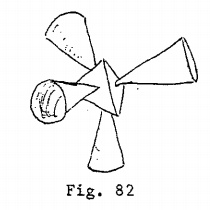
THE DIRECTIONS FOR BUILDING MATTER
"There are, in each of the five Platonic solids, a number of surfaces and corners," writes Jinarajadasa, "these give the directions for the building of the chemical elements. Taking the first three solids -- the Tetrahedron, Cube and Octahedron -- we have:
| SOLID | SURFACES | CORNERS |
|---|---|---|
| Tetrahedron | 4 | 4 |
| Cube | 6 | 8 |
| Octahedron | 8 | 6 |
"We find that these three solids are the 'tanmatras' -- 'the measures of THAT' -- or axes for the building of the divalent, trivalent, and tetravalent elements of the Periodic Law (of atoms). Thus all divalent elements, both positive and negative, paramagnetic and diamagnetic, with the single exception of Oxygen, are of the general type of Beryllium (Glucinum), illustrated in Fig. 82. (right)
"Atoms of the positive and negative types are massed together in groups, but especially in four main groups or 'funnels', which radiate from the centre of the tetrahedron to its four surfaces. This is the simple divalent structure for the lighter elements; in the heavier-elements there appear, in addition to the 'funnels', new groups termed 'spikes', four in number, and radiating from the centre to the four corners. (The unit of each element is surrounded by a spherical limiting wall, composed of the circumambient matter of the atomic sub-plane of the physical plane, but for the sake of [6] simplicity this is not shown in the diagrams.)
"All trivalent elements, with the single exception of Nitrogen, are of the type in Fig. 83 (left); the lighter trivalents are composed of six 'funnels' radiating from the centre of the cube to its six surfaces; the heavier trivalents have, in addition to the six funnels, eight 'spikes' radiating to the eight corners of the cube.
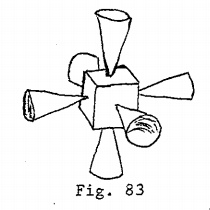
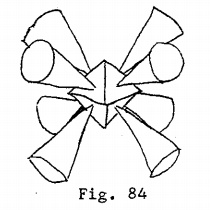
"All tetravalent elements, with the exception of Titanium and Zirconium, are of the type in Fig. 84 (left); the lighter tetravalents are composed of eight 'funnels', starting from the centre of an octahedron and pointing to the eight surfaces; the heavier tetravalents have, in addition, six 'spikes' pointing in the six corners.
"There remain the dodecahedron and the icosahedron; the former is the 'tanmatra', not for any one type of the elements, but for a constituent of some of the elements. This constituent is composed of groups of atoms which are placed at the twenty corners of a dodecahedron. Except that the icosahedron is implied in a dodecahedron -- for the corners of an icosahedron are the twelve points where the five tetrahedra regularly intersect -- no definite groups of bodies in the building of the elements have so far been noted, as placed at the twelve corners of the icosahedron."
For the student of the natural sciences who wishes to push on into the technical details of occult chemistry, we recommend Jinarajadasa's "First Principles of Theosophy", and also Besant and Leadbeater's "Occult Chemistry". Enough has been given here to indicate to the student of the Mysteries that he can train himself to think as God thinks, from the center of things outward; and thus he or she eventually becomes a God, or Goddess.
It seems likely that Pythagoras was initiated into the use of this kind of creative thinking when he studied occult science under the high priest, Psonchis, at the capital of Egypt, Sais, in the Sixth Century B.C. Psonchis was high Priest of Neith, a goddess whom the Greeks called Athena. It was Psonchis who gave Solon the date for the sinking of Atlantis, 9564 B.C. They kept long and accurate records! The "college" of the Mysteries was still in existence when Plato journeyed to Egypt a couple of hundred years later, to drink from that fount of Western wisdom. Then he went back to Athens to open up his Lyceum, in 387 B.C. That standard for Western universities lasted for 900 years, until a right-wing political fanatic, Roman emperor Justinian, closed down all schools of philosophy.
SQUARING THE CIRCLE
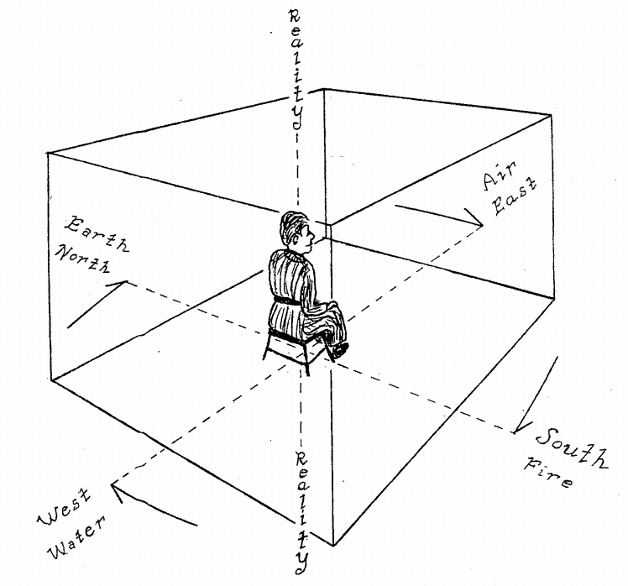
Taking his cue from Nature (God) the student geometrizes his thinking along the lines suggested by the atomic structure in Fig. 83 on the preceding page. This Cube of Space is your own little universe. You, as a point of consciousness, are its center; but it more convenient to think of this "center" as a vertical shaft around which the whole figure revolves. This shaft is your Reality, the universal symbol of Male or Positive Polarity, I AM. Around you is the passive universe, awaiting the impregnation or stimulation of your thought. This is Awareness, the results of your thought, [8] feeling and action reflected back to you. The Cube of Space can be any size. It should be varied occasionally in meditation to break the mind free from stereotyped images and crystallizations. The basic orientation at the physical level is the Four Directions as shown. The Student of the Western Tradition sits facing East, the direction of the rising sun and the constellation Aries.
For occult study purposes the Four Elements of the physical world are correlated with the Four Directions: the Air of the Wise in the East, the Fire of the Wise in the South, the Water of Wise in the West, and the Earth of the Wise in the North. We presume you have chosen to work with Evolution, rather than to oppose it; so the hooked cross is shown as revolving clockwise.
THE KABALISTIC CROSS
A simplified expression of this Squared Circle mandala is the Kabalistic Cross, shown below. From the English translation of the sacred Hebrew phrases you can see that the Cross comes at the end of the Lord's Prayer. Touch the forehead, the solar plexus, the right shoulder, the left shoulder, and clasp the hands before you with slightly bowed head, for the final phrase. Chant the Cross in Hebrew or in English, whichever you prefer, and under the breath if it would attract too much attention.
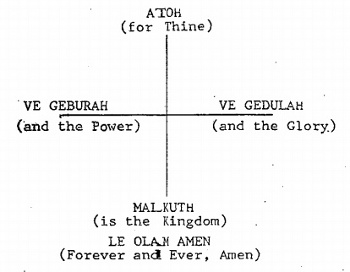
Use of the Cross should precede every meditation, and follow it. It declares your dominion over the four elemental forces within you: Air, Fire, Water and Earth, and thus prepares you for controlled contact with the Elemental Forces without! If you are successful, in time you will need stronger protective rituals such as the Lesser Banishing Ritual of the Pentagram. For now, the Kabalistic Cross should take care of any adverse forces which will try to take control of you as a result of spontaneous clairvoyance or clairaudience resulting from continued mental use of the Hexahedron or any other of the Platonic Solids, the "playthings of Dionysius".
Use of the Kabalistic Cross is highly recommended as a mental and emotional stabilizer. It will be desperately needed by all of us as the planet is purged of the grosser Elemental forces in the years ahead. The chaos created by the contending forces will be unbelievable.
References
- Roberts, Jonathan M. "Euxenus: A Pythagorean Philosopher." Antiquity Unveiled: Ancient Voices from the Spirit Realms Disclose the Most Startling Revelations Proving Christianity to Be of Heathen Origin. Philadelphia: Oriental Pub. Co, 1892. 264-268. Print. [Digital: <https://archive.org/details/antiquityunveile00robe>]
- Jinarājadāsa, Curuppumullagē. First Principles of Theosophy. Adyar, Madras, India: Theosophical Pub. House, 1921. Print. [Re-ed., 1967: ]
- Gamow, George. One, Two, Three ... Infinity: Facts & Speculations of Science. London: Macmillan & Co. Ltd., 1946. Print. [Bantam, 1971: ; re-ed., 1988: ]
- Pauwels, Louis, and Jacques Bergier. The Dawn of Magic. Gibbs & Phillips, 1963. Print. [Later re-issued as The Morning of the Magicians, 1968: <>]
- Besant, Annie, and C. W. Leadbeater. Occult Chemistry: Investigations by Clairvoyant Magnification into the Structure of the Atoms of the Periodic Table and of Some Compounds. Revised/Expanded ed. Adyar, Madras, India: Theosophical Pub. House, 1951. Print. [Digital, ed. 1919: <http://gutenberg.org/ebooks/16058>]
